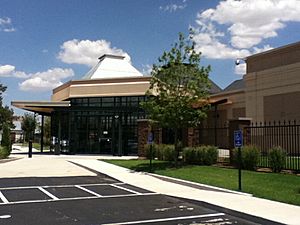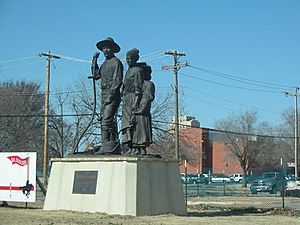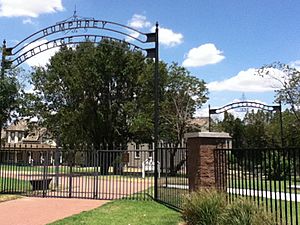Cherokee Strip Regional Heritage Center facts for kids
The Cherokee Strip Regional Heritage Center (CSRHC) is an exciting museum in Enid, Oklahoma. It teaches visitors all about the history of the Cherokee Outlet. This was a huge piece of land in Oklahoma. The museum also focuses on the famous Land Run that happened on September 16, 1893. This was when people raced to claim land.
The museum used to be called the Museum of the Cherokee Strip. It has been made much bigger, now covering 24,000 square feet! At the Heritage Center, you can explore many different things. There are galleries with exhibits that stay for a long time, and others that change. You can also find a research center and a special place called the Humphrey Heritage Village.
Contents
The Museum's Journey: How It Started
Talk about creating a museum in Enid began way back in the 1940s. People wanted to show off items from the 1893 Land Run. In 1951, Harry H. McKeever started collecting historical items. He also interviewed people who had been part of the Land Run.
Early Homes for the Museum
The first museum opened on September 14, 1951. It was in the basement of the courthouse. This opening happened during the yearly Cherokee Strip Land Run celebration. In August 1953, the museum moved to the basement of the Enid Carnegie Library. Then, in 1957, it moved again. This time, it went to the basement of an old post office building.
That post office building was later taken down. A new public library was built there. So, the museum moved once more, to Convention Hall. In 1962, Phillips University and the Sons and Daughters of the Cherokee Strip decided to combine their museums. The combined museum opened in November 1966. It was located in the university's old library building, built in 1914.
Finding a Permanent Home
The Museum of the Cherokee Strip officially opened at its current spot. This was on September 13, 1975, at 507 S. 4th St. Groups like the Garfield County Historical Society helped collect items. They also worked with the Sons and Daughters of the Cherokee Strip Pioneers. These groups saved many historical items from the Cherokee Outlet. These items are now on display at the museum.
In 2005, a new partnership was formed. The Oklahoma Historical Society, the Sons and Daughters of the Cherokee Strip, and the Phillips Legacy Foundation worked together. They created the Cherokee Strip Regional Heritage Center, Inc. Their goal was to build a brand new museum. The Cherokee Strip Regional Heritage Center opened its doors to the public on April 1, 2011. The Oklahoma Historical Society now runs the Heritage Center.
What You Can See: Galleries and Exhibits
The museum has exhibits that are always there. They tell the story of how people first settled the area. This happened after the Land Run of 1893. You can learn about how farming grew in the region. There are also exhibits about the discovery of oil. And you can see how the early train industry developed. Other exhibits focus on Phillips University and the history of Enid, Oklahoma.
The Heritage Center also has a special gallery for temporary exhibits. These shows change over time. For example, on September 16, 2010, the museum featured a photography exhibit. It was called "Cherokee Nation: Portrait of a People" by David Fitzgerald. This was the very first exhibit in the temporary hall. It opened before the rest of the museum's permanent exhibits were ready.
Digging Deeper: The Research Center
The Heritage Center has a research center. It holds a large collection of historical materials. This includes old photographs and recorded interviews. You can also find old newspapers and information to help with family history. There is also a library with many reference books. A full-time expert is there to help visitors. They can assist you with any research questions you might have.
Step Back in Time: Humphrey Heritage Village
The Humphrey Heritage Village is a living history village. It is located right on the grounds of the Cherokee Strip Regional Heritage Center. This village has old buildings from northwestern Oklahoma. For example, you can see Enid's U.S. Land Office. This building was used during the Land Run of 1893. Other buildings include the Glidewell house. There is also Enid's first Episcopal church. And you can visit the Turkey Creek School House.
See Also
- Regional heritage
- Oklahoma Historical Society
- Cherokee Outlet




